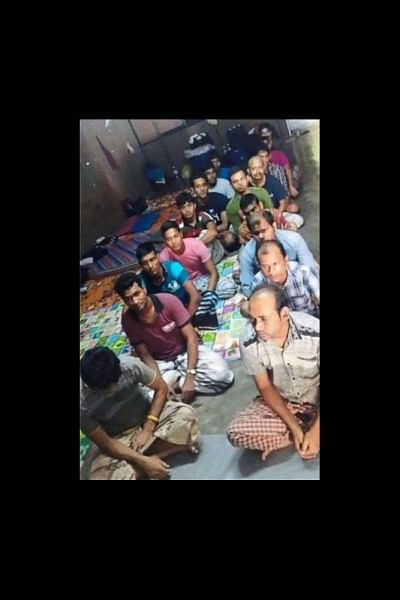The new slaves of Malaysia

News of reprehensible activities of cross border human traffickers has begun to resurface. Last Tuesday, the state news agency of Malaysia, Bernama, reported that in a raid in Taman Sungai Puyu in Penang, the police force rescued 27 Bangladeshi men who were victims of human trafficking. The report also informs that three men, believed to be members of the trafficking syndicate, have also been apprehended. According to the local police, "The skinny and listless Bangladeshis aged between 20 and 40 were found in two houses that had been padlocked". Preliminary investigation revealed that the men had been locked up in the houses by the syndicate for the last two months, and were each given roti chanai a day and tap water to drink. Not surprisingly, they were subjected to torture if they tried to escape.
The most revealing part of the police account was: "All the foreigners are believed to have entered the country legally but the syndicate that had promised them jobs locked them up and intended to sell them off to their potential employers". The grisly exposure go on to enlighten that each of them were charged a certain fee to be brought into Malaysia, and they were sold off for RM 3,000 (Tk. 51,000) each to potential employers.
The efforts of the Malaysian police in rescuing this group of forcibly interned Bangladeshi labour migrants are praiseworthy. However, it is also a stark reminder that syndicates of human smugglers and traffickers are still active, that they continue to cater to the needs for cheap labour of the local market, that the borders that delineated the concepts of labour migration, human smuggling and trafficking and between regular and irregular flows have all become overlapping and murky. Most worrisomely, unsuspecting migrants going through the formal channel in order to eke out a living in a distant land seem to be becoming virtual slaves, only to be sold at chattels at a price that even a calf does not sell in the cattle markets of Bangladesh that mushroom in preparation of Eid-ul Azha.
This turn of events takes place in the backdrop of the uncovering of scores of mass graves and rescue of hundreds of Rohingyas and Bangladeshis in high seas in the Andaman and the Bay of Bengal, and inmates from illegal detention centres in remote regions of Malaysia and Thailand late last year. As in most such cases, the public outrage lasted for a certain duration, the media remained engaged for a while, the respective governments promised action against the perpetrators that did not eventuate in any substantive redress, and regional conferences were convened that viewed the movement as irregular flow, and dealt with it from a national security perspective, instead of emphasising on the root causes, issues of labour migration and the human rights perspective.
In reality, individually, the concerned states did little to apprehend the real perpetrators. In Bangladesh, a few low level operators of trafficking gangs of the Cox's Bazar-Teknaf region became victims of "cross-fire". Needless to say, the evidence of involvement of the 'big-fishes' got buried with them. At a conference organised by the National Human Rights Commission in Dhaka, the members of civil administration and representatives of various law enforcements publicly acknowledged their incapacity to rein in such 'big-fishes'. Likewise, in Malaysia, the initial moves to take action against the perpetrators appear to have run out of steam. Although in Thailand, an unswerving General took some meaningful actions against the trafficking/human smuggling syndicates, within months he was forced to flee the country and seek asylum in Australia. All these indicate how lucrative the new slave trade has become and how powerful the trafficking syndicates are and how far the reach and muscle of their arms can extend. They also lay bare the incapacity, if not unwillingness, of the states, to individually and collectively confront the grave crisis in proper stride.
In all likelihood, the Penang case epitomises only the tip of the iceberg of deceit, violence and servitude of migrants. The facts make it difficult for the states to hide behind their standard defense that the migrants flouted immigration laws of their lands on their (the migrants') own volition, and thus, the onus lies on them for their predicament. The Malaysian police have on record stated that "they had entered the country legally". So, the obvious questions that arise are why have these migrants in regular status met the fate that they did? What processes led them to such precarious status? What has been the role of the respective governments in ensuring their safe migration? What follow-up initiatives are being taken so that the perpetrators are brought to justice? What are the lessons to be learnt? What safety and monitoring mechanisms are to be put in place before proceeding with sending fresh workers under the recently mooted G2G+ system?
The Penang incident should not be treated as an isolated trafficking case. It should be taken up as a wake-up call for all stakeholders, in particular the states, engaged in promoting and facilitating labour migration.
The writer teaches International Relations at the University of Dhaka and coordinates the Refugee and Migratory Movements Research Unit. He teaches and writes on migration and rights issues.

 For all latest news, follow The Daily Star's Google News channel.
For all latest news, follow The Daily Star's Google News channel. 








Comments